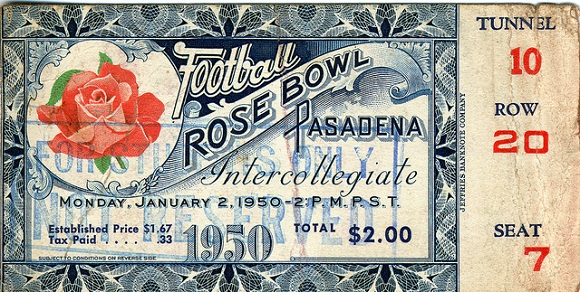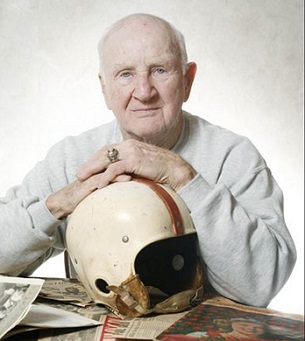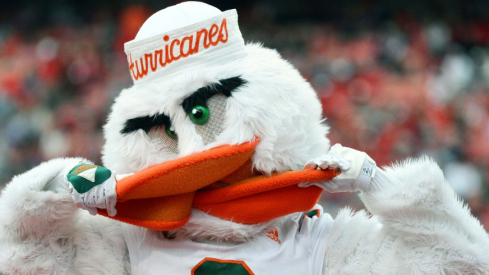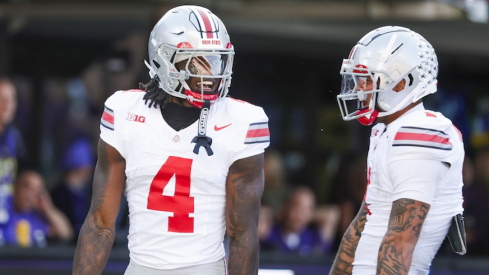
(Note: if you are heading to Cal for the game this week, check out my "Road Tripping" story for tips on where to go for food and entertainment in the Bay Area.)
Pasadena. The Parade. The stars. The pageantry and the pride of representing your state and your conference. All of these things have long been standard fare for the Rose Bowl, and many former Buckeye players can tell you about their experiences there. Few, however, can say they were part of Ohio State's first Rose Bowl victory.
The 1949 OSU football team finished the regular season with a 7-7 tie at Michigan, which meant the two teams were tied for the Big Ten championship. In those days, the tie-breaker was that they would send the team that had not been there in the longest time. Ohio State's only previous Rose Bowl appearance came after the 1920 season, and so they won the tie-breaker and were awarded the coveted trip to Pasadena.
Having never played there before, the players had never seen any of the festivities that surrounded the trip and knew of them only by reputation. Part of the week's activities was a celebrity dinner only a few days before the game, an event at which the players rubbed elbows with screen legends such as gorgeous 17-year old heart-throb Elizabeth Taylor and legendary comedy star Bob Hope. On another day, Hope's movie partner Bing Crosby showed up to watch the Buckeyes practice.
This would be the first time that the Rose Bowl would be shown on network television, and there was a bit of irony in the fact that Ohio State was playing. The Buckeyes were not a marquee team that year; they had barely won their conference and they had no major stars (yet). Their starting quarterback Pandel Savic is now known more for his stewardship of the Memorial Golf Tournament than he is for his gridiron exploits. Names like Krall, Janowicz, and Scnittker would not exactly roll off the tongues of the slick men in the TV broadcast booth.
But the Buckeyes were thinking more about school pride than they were about starlets and television. The team they were going to play was the California Golden Bears, a team that had compiled a perfect 10-0 record and was currently ranked third in the country. Cal would most certainly be favored going into the game. Ohio State's only previous Rose Bowl game had also been against Cal, and the Buckeyes fell on that day by a score of 28-0. The OSU players were determined to make a good showing this time around, no matter what it took.
The game initially looked like it would provide little entertainment for the network audience. The two teams went back and forth in the first quarter with nothing to show for it, but the second quarter was more eventful. Ohio State drove down to the Cal 10-yard line, and from there fullback Curly Morrison carried it in for an apparent touchdown. Unfortunately, OSU was flagged for illegal use of hands on the play, and it moved the ball back to the 23. That was a bad sign.
Morrison carried again on the next play, but he was hit hard and he coughed up the ball. Cal recovered on the Buckeye 26, and from there they began a drive that would culminate in a four-yard touchdown run by Cleveland native Jim Monachino. It was a 14-point swing, and the OSU offense would not get that close again in the first half. However, the Buckeye defense stiffened after that, and the two teams went into halftime with Cal leading 7-0.
Opening up the second half, Cal took the ball and began driving again, but a funny thing happened on the way to the end zone. As Cal quarterback Bob Celeri dropped back to pass from inside Ohio State territory, he didn't notice OSU safety Vic Janowicz following his eyes. Janowicz jumped in front of the pass and intercepted it at the Ohio State 25-yard line. Showing off his running skills, Janowicz raced the other way and carried the ball all the way to the Cal 31.
This was a great break for the Buckeyes, and they took advantage of it. The drive to the end zone appeared to stall when OSU faced a fourth-and-five from the 14-yard line. Coach Wes Fesler called for a halfback pass, and Jerry Krall completed the pass for seven yards to keep the drive alive. From there, they stalled again but again Fesler went for it on fourth-and-goal from the two-yard line and Morrison carried it in for the score.
 Halfback Jerry Krall had 50 yards rushing and 20 passing.
Halfback Jerry Krall had 50 yards rushing and 20 passing. The interception by Janowicz completely changed the momentum. Cal went three-and-out on their next possession, and Celeri, who doubled as punter, dropped back inside his 20 to kick. OSU's Bill Trautwein busted through the line and blocked the punt. Starting center and team MVP Jack Lininger recovered and took it down to the Cal 6-yard line to put the Buckeyes in business again.
Three plays netted only four yards, and so Fesler again had to decide whether to go for the touchdown or kick the field goal. Again he chose to go for it, and it paid off again as Krall took it in for the score. The PAT gave Ohio State an improbable 14-7 lead in a game where they had hardly had any sustained success on offense.
The sudden turnaround seemed to wake up the Bears, and they drove to a tying touchdown on their next drive, with Monachino once again doing the damage on a 44-yard run. Thus, the third quarter ended with a 14-14 deadlock, setting the stage for dramatic action in the fourth.
As it turned out, there was not much drama until the end. The two teams were stalemated until another special teams disaster put Cal behind the eight ball late in the game. With under three minutes to go, Celeri dropped back to punt again, this time from inside his own five-yard line.
The snap from center was low, and Celeri struggled to scoop it off the ground. As he gained control, he saw that the OSU rush was closing in on his right side, so he scrambled to his left and had to punt with his off-foot (his left). The resulting shank went out of bounds at the Cal 13, once again setting the Buckeyes up in prime scoring position.
OSU ran three rushing plays but got only to the five, which left them in a fourth-and-two situation. With just under two minutes remaining, Fesler decided this time to go for the field goal, and so he sent out backup quarterback Dick Widdoes to hold for kicker Jimmy Hague, who was already on the field as the starting right end. But the players wanted to go for the touchdown and so, in a remarkable display of defiance for the time, they sent Widdoes back to the sideline.
Fesler was having none of that, and he sent Widdoes back onto the field with strict orders that they were going to kick. By this time, the play clock had run out and the Buckeyes were penalized five yards for delay of game. And so the players relented and Hague booted the go-ahead field goal to put Ohio State up 17-14. Cal attempted to rally in the time they had left, but Widdoes intercepted a pass to seal the victory. After the closing gun sounded, the players carried Fesler off the field on their shoulders.
Morrison finished the game with 119 yards on 25 carries and was named the Most Valuable Player. The team finished the season with a record of 7-1-2, with four of those victories falling into the category of "come-from-behind". The AP ranked Ohio State sixth in their final poll.
Despite the win, Fesler was growing weary from the pressure of running what had become a big-time college football program. He almost resigned that January, but university officials convinced him to stay with the promise of a faculty position when he finally decided to retire from coaching football. That promise would never be fulfilled, however, because Fesler left after the next season and went into the business world. He would eventually get back into coaching, but he never achieved the level of success that he had at Ohio State. Fesler's replacement at OSU? Well, it was a guy named Woody.
Janowicz would go on to have an outstanding season in 1950 and ended up claiming OSU's second Heisman Trophy award. When Hayes took over in 1951, he changed the offense and Janowicz received fewer carries, but he never complained. He was a guy who contributed to the team and won football games, just like the rest of the guys who made 1949 such a special year for the program.

